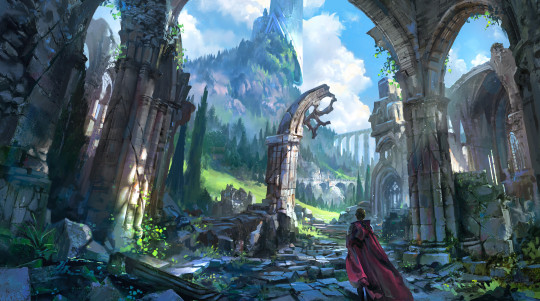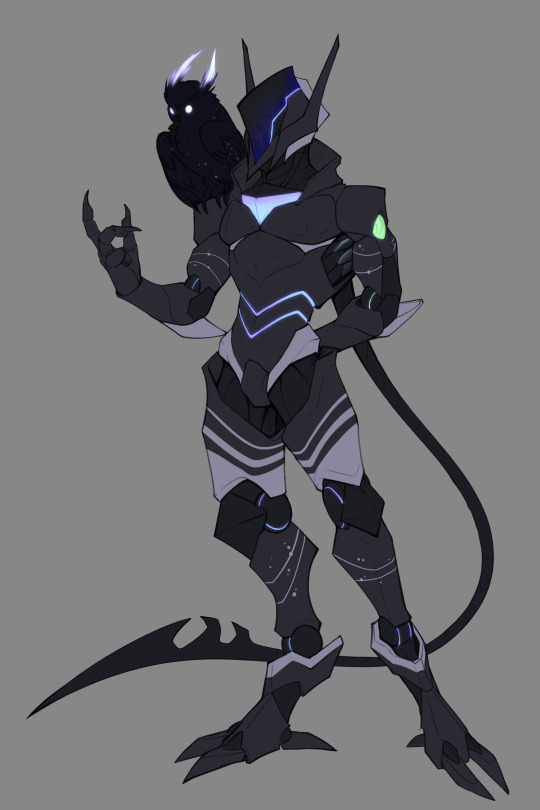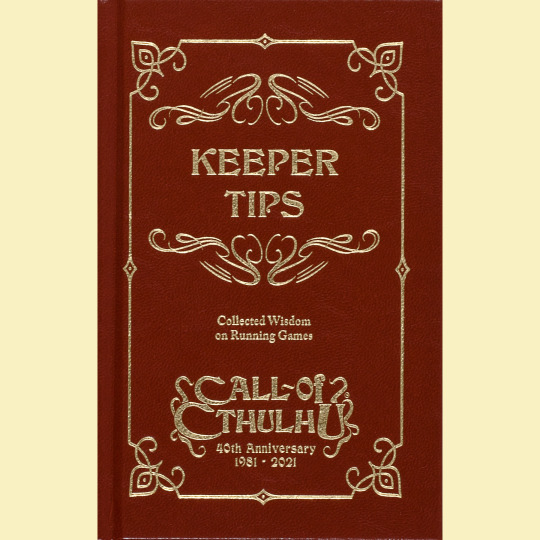#ttrpg tips
Text
D&D/TTRPG campaign concepts
want to narrow down what kind of campaign you and your players would like to play? try showing your players this list (or a curated version of it) and having them choose their top favourite concepts! alternatively, you can simply roll!
typical fantasy
dungeon crawl
hex crawl
curses
political intrigue
patrons
gothic
sandbox
seasonal
sailing/ocean
flying/sky
gambling
tailored to an all-1-class party
tailored to an all-1-background party
tailored to an all-1-alignment party
interplanar
post-apocalypse
collecting
blighted world
arena
take stock of the most popular options. how can you mix and match them, and do you want to? negotiate with the players, asking what (if anything) they refuse to play.
some examples of possible mixing and matching include:
sailing/ocean + blighted world = a world where only the ocean is safe from a corruption that plagues the land.
curses + all-1-class party = a party of druids has been cursed to lose control of their wildshape abilities, and must either live with it or try to find a way to reverse the spell.
dungeon crawl + interplanar = there's a portal the party needs to use, and they must go through numerous dungeons in different planes to find it.
gothic + patrons = the party has been hired by a vampire lord to perform various quests to further their nefarious plots. the party seems willing to play along... do they know?
gambling + arena = there's an artifact at the casino, and it's too heavily-guarded to steal. the party's best bet at making money locally is surviving the arena.
political intrigue + post-apocalypse = navigating the politics and wars of desperate nations in a time of great scarcity.
#ttrpg tips#campaign ideas#campaign concepts#setting concepts#worldbuilding#post apocalypse campaign#gothic campaign#pirate campaign#evil campaign#dungeons and dragons#D&D#TTRPG
11 notes
·
View notes
Text
Cannot stress enough that if you are a forgetful player you can make a to-do list and group it by things to do this session, on this adventure, on your next shopping trip, and overall arc/campaign goals. Bold priorities
#as a forgetful player who 1. forgot to protect her animal companion (he lived but i have to do it again tonight)#and 2. forgot to buy a morningstar for months and months and months#dnd#ttrpg#ttrpg tips#dnd tips
92 notes
·
View notes
Text
guys omg my notes for my first ever dnd session as a dm r done…. i’m so nervous….. is there any thing specific i need to like make sure i add?
#gengars silly rambles#gengar plays dnd#dnd tips#dm tips#dungeons and dragons#ttrpg tips#dungeon master#just roll with it#jrwi
5 notes
·
View notes
Text
The Imposter Syndrome
All DMs come to a point where we start to question: Is the story I am running good enough? Is it interesting? Is the combat boring? It happened before the rise of streaming games, and it happens now that there are roleplaying media stars.
When the goblin of self-doubt starts nibbling at your self-esteem, remember:
Your players show up every week to play. That's the measure of how good a DM you are, and the only one that matters.
4 notes
·
View notes
Text
I am obsessed with this idea
36K notes
·
View notes
Text
One stop shop for naming wizards/elves/any being of the long ago https://www.drugs.com/drug_information.html
1 note
·
View note
Text
Every time I look at how to create a world for a campaign or just plan a campaign on the internet you usually get : start small with the town and maybe the few places around, you don't need to know everything about the world to start the campaign.
However what if your players want to create characters that come from beyond that place. You'll need to tell them what the world is like, what others kingdoms and lands there are and what is happening in there for them to be able to put their character in there and know what is going on so they have some guidelines about the world's alliances etc ?
How do you do ? (Also if I'm looking at it wrong please tell me I am but an aspiring DM)
394 notes
·
View notes
Text
Just a friendly reminder for DMs: Many brands of wrapping paper has a 1x1in grid on the back, the perfect size for d&d maps, and all the holiday paper is currently on sale
959 notes
·
View notes
Photo

Drafting the Adventure: Dungeons Without Walls
I love the idea of dungeons, but there was a significant portion of my life as a DM where they didn’t feature in my games. While Pathfinder and 5e provided a great framework for character building and tactical skirmishes that I could build story on top of, neither was really great when it came time to detour into a dungeon. My players tended to get confused when we headed out to plunder the local ruin or cave system, spending a lot more time figuring out where they were and what they should be doing than actually doing anything.
The problem as it turned out was limited information. I had a picture of the dungeon in my head/notes but I couldn’t telepathically infer that to the party, and the back and forth questions where they tried to orient themselves within my mental labyrinth ate up a lot of session time prevented us from attaining that snappy pace that every table needs to keep the players invested.
Recently though I had an epiphany about overhauling exploration in d&d, and wrote up a whole post detailing how you could build and run wilderness adventures the same way you could a heist or a murder mystery. Because I was already writing a series about dungeon design it didn’t take long for me to realize that this exploration overhaul was 100% applicable, and could solve a lot of the delay and confusion my players usually faced on their next trip underground. Spoilers: it worked amazingly.
The key to this overhaul was giving my players enough information to see the dungeon as a sort of abstract checklist, and then giving them the power to investigate and check things off that list in whatever order they wished, when they enter a new level of the dungeon they get a new checklist to fill out which still keeps that sense of exploration. Folk love checking things off lists, and I as a dungeonmaster love it when players engage with the content I’ve spent so much energy creating even if it’s only poking their head in the door to realize they want to run away as fast as possible. Likewise, designing the dungeon this way let me tackle much larger concepts without having to sweat the details of filling up every little room as I would have to in map-centric design.
To summarize my exploration mechanic as It applies to dungeons:
During Design: After you’ve got the dungeons’ major concept, you divide it into unique “zones” (essentially what might be levels in a regular dungeon) with an interconnected theme, mechanic, or threat.
Each zone has a number of points of interest, which can be anything from trails to follow, odd sights they might investigate, to full complexes of rooms that you’ve mapped out. You don’t need to map out the points of interest otherwise, they sort of float abstractly within the zone
When players enter a zone, they become aware of its name and general descriptor, as well as how many total points of interest are in that zone. They also become aware of some points of interest immediately to serve as landmarks and give them a direction for their exploration, but most remain undiscovered until they venture off the path and start checking out their surroundings. Hidden among these points of interest are the doors that lead to zones deeper within the dungeon, encouraging the party to explore in order to progress.
During Play: When the players enter the dungeon, one player is appointed as the surveyor, who’s job it is to keep track of the zones, fill out that checklist, and check things off when the DM tells them that they’ve fully explored a point of interest.
Rather than needing to be aware of the exact room layout, the party just need to know what zone they’re in and what options are available to them, Because this information is delivered in the form of a checklist with empty spaces, the party know exactly how much of the dungeon they’ve explored, what’s left to explore, and when they’ve cleared out an area.
Lets take the image above as inspiration. Say the party is trying to make it up to the tower, you can easily see a progression of zones and maybe imagine a few to go alongside them:
Ruins & Foothills: The first area, filled with the remnants of an ancient civilization. Picked over by looters and now a home to all sorts of wildlife,
Mountainside: The obvious next goal, but locked off behind a challenging climb, Filled with hazards that threaten to knock the party back down to the foothills if they’re not careful
Caverns: Secret area accessible only if the party explore a cave on the mountainside, or make a beeline towards the old aqueduct landmark in the foothills, realizing it might be easier than the climb.
Spire Foundations: The door connecting to the foothills is guarded by a complex puzzle and arcane ward, but the party might be able to sneak in through the caves where erosion has caused a breakthrough into the cellars.
Spire Peak: High among the clouds, the party’s prize is somewhere here. Access to the upper sections of the tower are guarded by a territorial sphinx under arcane compulsion, though the party might just be able to skip that fight if they figure out the riddle to make the portal mirrors work in the foundations.
Trying to design all this by pencilling it in on a gridmap would take weeks, to say nothing of the headache it’d cause you trying to make things fit together and fill up empty space with content. Designing it first as a sequence of zones and then filling those out with interesting fights, puzzles, and encounters is the work of an afternoon or two. Likewise, its easy on your players: five zones with six to ten points of interest is far easier to tackle when you can make a checklist and see how much progress you’ve made, despite the fact that the area they’re exploring is quite vast.
I hope you find this as useful as I have, and if you need a more concrete example of how it might work, don’t worry, I’ll have one of those for you in the coming days.
#dungeon design#dnd#dungeons and dragons#d&d#5e#dm advice#dm tip#dm tips#dm tools#writing advice#pathfinder#ttrpg#homebrew#5e homebrew#homebrew mechanic#exploration
612 notes
·
View notes
Text
if you are a dungeon master (or even a fantasy author/worldbuilder of any kind) and you don’t know about donjon let me make your life a million times easier
want to make a fantasy calendar with your own year-lengths, weeks, months, and lunar cycles? https://donjon.bin.sh/fantasy/calendar/
need to come up with some medieval town demographics? https://donjon.bin.sh/fantasy/demographics/
want to make a map and layout of a city/town? https://donjon.bin.sh/fantasy/town/
want a fleshed-out tavern complete with menu, innkeeper, patrons, rumors, and secrets? https://donjon.bin.sh/fantasy/inn/
leading your players through a dungeon and want to customize the size, treasure, layout, theme, etc? https://donjon.bin.sh/5e/dungeon/
tired of creating lists of magic items for different shops to sell, or hoards to be looted? https://donjon.bin.sh/5e/magic/shop.html and https://donjon.bin.sh/d20/treasure/
even a customizable initiative tracker! https://donjon.bin.sh/d20/initiative/
and that’s only scratching the surface! I really recommend all dms check this out. oh, and it’s completely free!
#donjon#dm#dungeons and dragons#d&d#gm#worldbuilding#cr#dm tips#dm advice#ttrpg#game master#dungeon master
486 notes
·
View notes
Text


Orionis update after being gone for 3 sessions!
He ditched his protective visor, coverd the arm that's glowing green with.. something? And he got an owl (that is actually his patron)!
He's a gunslinger/witch now
#just realised I misscoloured the tail tip on the coat drawings oops#it was supposed to be black still#orionis#pf2e#oc#automaton#robot#art#digital drawing#digital art#artwork#drawing#sci fantasy#small artist#ttrpg
137 notes
·
View notes
Text
dice-generated supervillains
I have made 2 tables to roll on to randomly generate supervillains, based on my observations of trends in the Deck of Villainy book for Masks: A New Generation. I've bolded every other one for easy readability. here they are!
motive (roll 1d10):
family/creator(/s)/home (protect or ruin)
gaining power/wealth/influence
maintaining power/wealth/influence
returning to/maintaining "normality"
hedonism
keeping something alive/functional (self, treasured item, etc.)
destruction (reality, humanity, government, etc.)
targeted revenge
entering a desired world (ours, a future, an alien planet, etc.)
love (romantic interest/partner, an audience, etc.)
powers/abilities (roll 1d20 up to three times):
elemental (water, air, electricity, etc.)
summoning (human underlings, demons, animals)
superhuman toughness/strength/durability
life-stealing/supernatural healing/poison
mind-control/hypnosis/illusion
tech/gadgets/machinery
shapeshifting (partial, full, or extreme)
monstrous/nonhuman form (robot, alien, undead, etc.)
great wealth
charm/social control
intelligence/smarts/information
teleportation/incorporeality
giant size/tiny size/size shifting
possession
immobilisation (freezing, paralysing, trapping)
invisibility
reality control/gravity control/wormholes
superhuman speed/agility/acrobatics
clones/doubles
weapons
go nuts on the interpretations, and if you want to share what you've generated in the tags/replies/comments of this post then go for it! also, if you want to make your own posts with art/stories of villains generated with this table, feel free to @ me!
#GM tips#ttrpg tips#masks: a new generation#backstory creation#character creation#supervillain#villain#superpowers
7 notes
·
View notes
Text
fun dm tip
if your players roll a perception check and ask "is there a [insert specific thing that I definitely didn't design but go off queen] nearby"
say
yes
always
#within reason#“is there a flamethrower”#rolls nat 1#“yeah and somehow you tripped over it and are on fire”#“whoops”#"yeah:#dming#dnd character#dnd#dungeons and dragons#dnd5e#ttrpg#dnd ocs#homebrew#funny#tabletop rpg#dm tips
140 notes
·
View notes
Text

What a pure delight this book is. This is Keeper Tips (2021): “Collected Wisdom on Running Games,” published in celebration of Call of Cthulhu’s 40th anniversary. The idea here is for a group of esteemed keepers and game designers to offer short snippets of advice. Those snippets were then organized into thematic groupings — Horror, Inclusivity, Monsters, Props and so on.
There is no attempt at uniformity. All the contributors run (and write) very different sorts of games, so their advice runs the gamut, sometimes one paragraph of advice being contradicted by the next. Better: all of it is uncredited in-line. They become, in aggregate, like Buddhist koans to ponder, puzzle over, embrace or discard.
Because that’s the thing, right: it’s all valid! Every group at every table has different needs and wants, so there isn’t a “correct” way to play or run any game, just the best way in the needs of the moment. That’s perhaps the wisest lesson of Keeper Tips.
#roleplaying game#tabletop rpg#dungeons & dragons#rpg#d&d#ttrpg#Call of Cthulhu#Keeper Tips#Chaosium
113 notes
·
View notes
Text

I don't often talk about MacGuffin stuff on here (not sure why) but Jonny and I have been running these masterclass streams for our patrons and I'm really proud of them! This week's is about running your first game (ever or of a new campaign) and we'll talk a lot about the principles of structuring a session and engaging players, but also a bit about practicalities and figuring out your own GMing style. I think these streams (and accompanying VODs) are really good, so maybe check out our patreon if they seem like your kind of thing.
154 notes
·
View notes
Quote
I don't think you need all the backstory in the world. What backstory is there to do, is give you a sense of trajectory. Where you are coming from informs where you are going, and it's the going that's essential.
Brennan Lee Mulligan, on character building and character creation ("Game Masters of Exandria Roundtable")
#writeblr#critical role#writing tips#character development#writing advice#writing#brennan lee mulligan#character building#critrole#matthew mercer#novel writing#aabria iyengar#fiction writing#exandria#taldorei#ttrpg#tabletop gaming#exandria unlimited#critter hug
702 notes
·
View notes